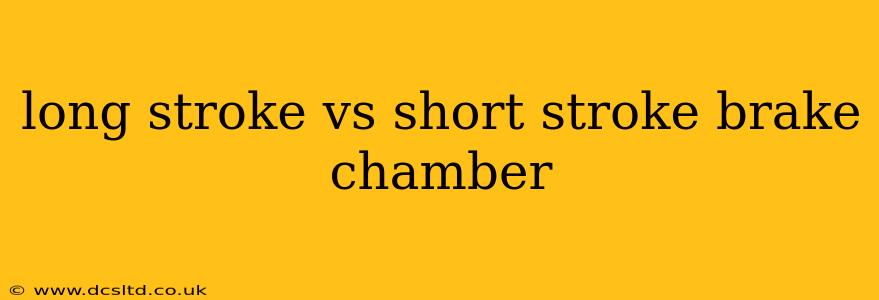Long Stroke vs. Short Stroke Brake Chambers: A Comprehensive Guide
Choosing the right brake chamber is crucial for optimal braking performance and safety in heavy-duty vehicles. Two primary types exist: long stroke and short stroke chambers. Understanding their differences is vital for fleet managers, mechanics, and anyone involved in maintaining or specifying braking systems. This guide will explore the key distinctions, applications, and considerations for each type.
What is a Brake Chamber?
Before delving into the specifics of long stroke and short stroke chambers, let's briefly define what a brake chamber is. It's a pneumatic device that converts compressed air pressure into mechanical force, activating the brake shoes or discs in a vehicle's braking system. The pressure applied to the chamber determines the braking force. The key difference between long and short stroke chambers lies in the distance the diaphragm travels to achieve full braking.
H2: What's the Difference Between Long Stroke and Short Stroke Brake Chambers?
The primary difference lies in the stroke length, which is the distance the diaphragm inside the chamber travels from its fully retracted position to its fully extended position under maximum air pressure.
-
Long Stroke Chambers: These chambers have a longer diaphragm travel, typically around 10-12 inches. This design allows for more mechanical leverage, resulting in greater braking force with less air pressure. They are generally more responsive to initial air pressure changes.
-
Short Stroke Chambers: These chambers feature a shorter diaphragm travel, usually around 6-8 inches. They require higher air pressure to achieve the same braking force as a long stroke chamber. Their shorter stroke results in faster response time in certain applications.
H2: What are the Advantages and Disadvantages of Long Stroke Brake Chambers?
Advantages:
- Higher braking force with lower air pressure: This is beneficial in situations where air pressure might be limited or fluctuating.
- Increased leverage: The longer stroke provides more mechanical advantage, resulting in a stronger braking force.
- Potentially better performance in harsh conditions: The increased leverage can help compensate for factors like wear and tear or less-than-optimal air pressure.
Disadvantages:
- Slower response time: Due to the longer travel distance, the response to changes in air pressure may be slightly slower compared to short stroke chambers.
- Larger size and weight: Their larger physical dimensions contribute to added weight and might require more space for installation.
- May be more costly: The increased complexity of the design might lead to higher manufacturing costs.
H2: What are the Advantages and Disadvantages of Short Stroke Brake Chambers?
Advantages:
- Faster response time: Their shorter stroke results in quicker activation of the brakes, leading to faster reaction times.
- Compact design: Smaller size and weight are beneficial in space-constrained applications.
- Potentially lower cost: The simpler design can result in lower manufacturing costs.
Disadvantages:
- Requires higher air pressure: Achieving the same braking force as a long stroke chamber necessitates a higher air pressure.
- Lower braking force at lower air pressures: This can become a problem in situations with inconsistent or reduced air pressure.
- Less sensitive to smaller air pressure changes: Smaller pressure variations may not result in a noticeable change in braking force.
H2: When should I use a long stroke brake chamber?
Long stroke brake chambers are often preferred in applications requiring high braking force under various conditions, such as:
- Heavier vehicles: Their increased leverage is advantageous for stopping heavier loads effectively.
- Applications with fluctuating air pressure: They can still deliver sufficient braking power even with inconsistent air pressure.
- Situations demanding greater braking force at lower air pressures: This may be relevant in older systems or those with potential air pressure leaks.
H2: When should I use a short stroke brake chamber?
Short stroke chambers are suitable for situations prioritizing rapid response time and compact design, for example:
- Applications where quick braking response is critical: Examples include certain types of trailers or situations demanding swift deceleration.
- Vehicles with limited space: Their smaller size makes them ideal for applications with limited space for installation.
- Modern systems with reliable and consistent air pressure: These systems are designed to provide the higher air pressure required for optimal short-stroke performance.
H2: How do I choose between a long stroke and a short stroke brake chamber?
Selecting the correct brake chamber depends entirely on the specific requirements of the vehicle and its operating conditions. Consider factors such as vehicle weight, required braking force, available air pressure, response time needs, and available installation space. Consulting the vehicle's specifications and seeking advice from a qualified mechanic or brake specialist is highly recommended. Incorrect chamber selection could significantly impact safety and braking performance.
This comprehensive overview should assist you in understanding the key differences between long stroke and short stroke brake chambers. Remember to always prioritize safety and consult relevant professionals for guidance on choosing the appropriate braking system components for your specific needs.
